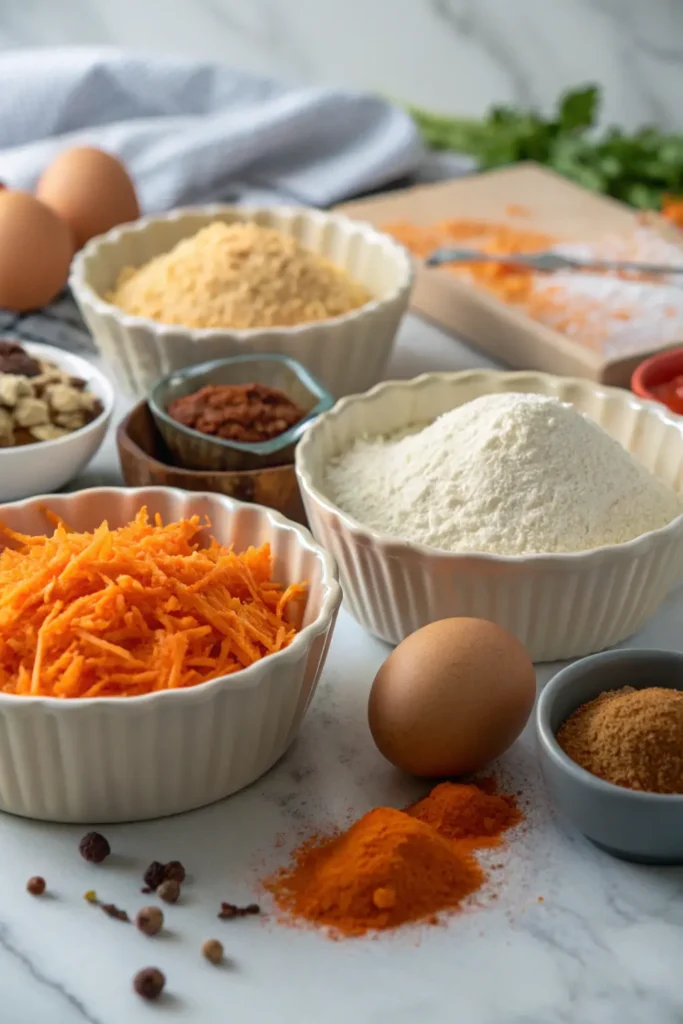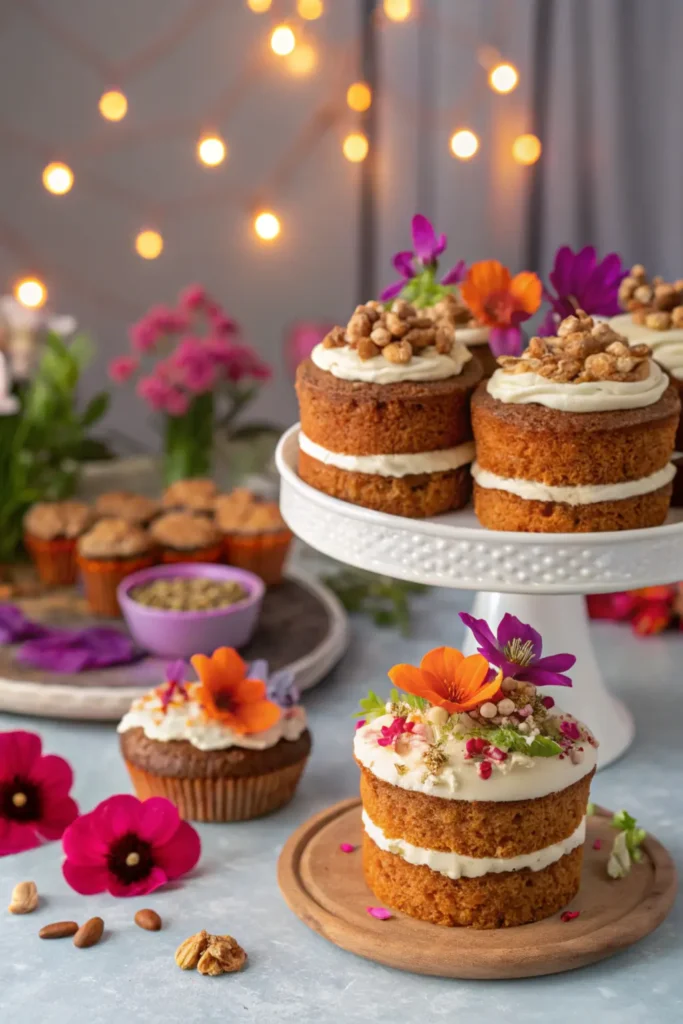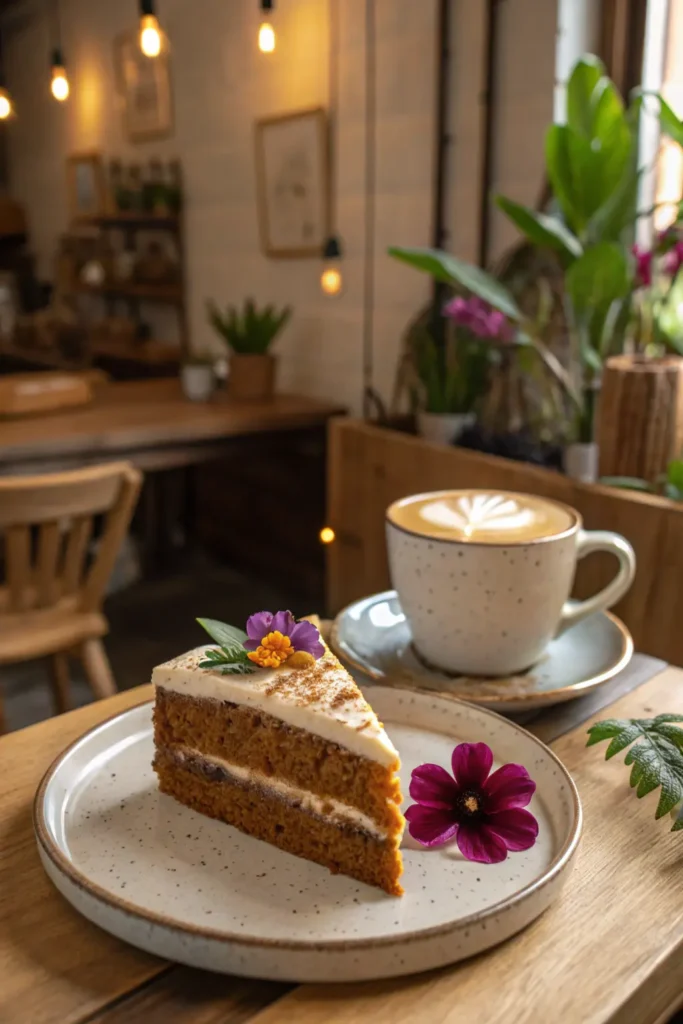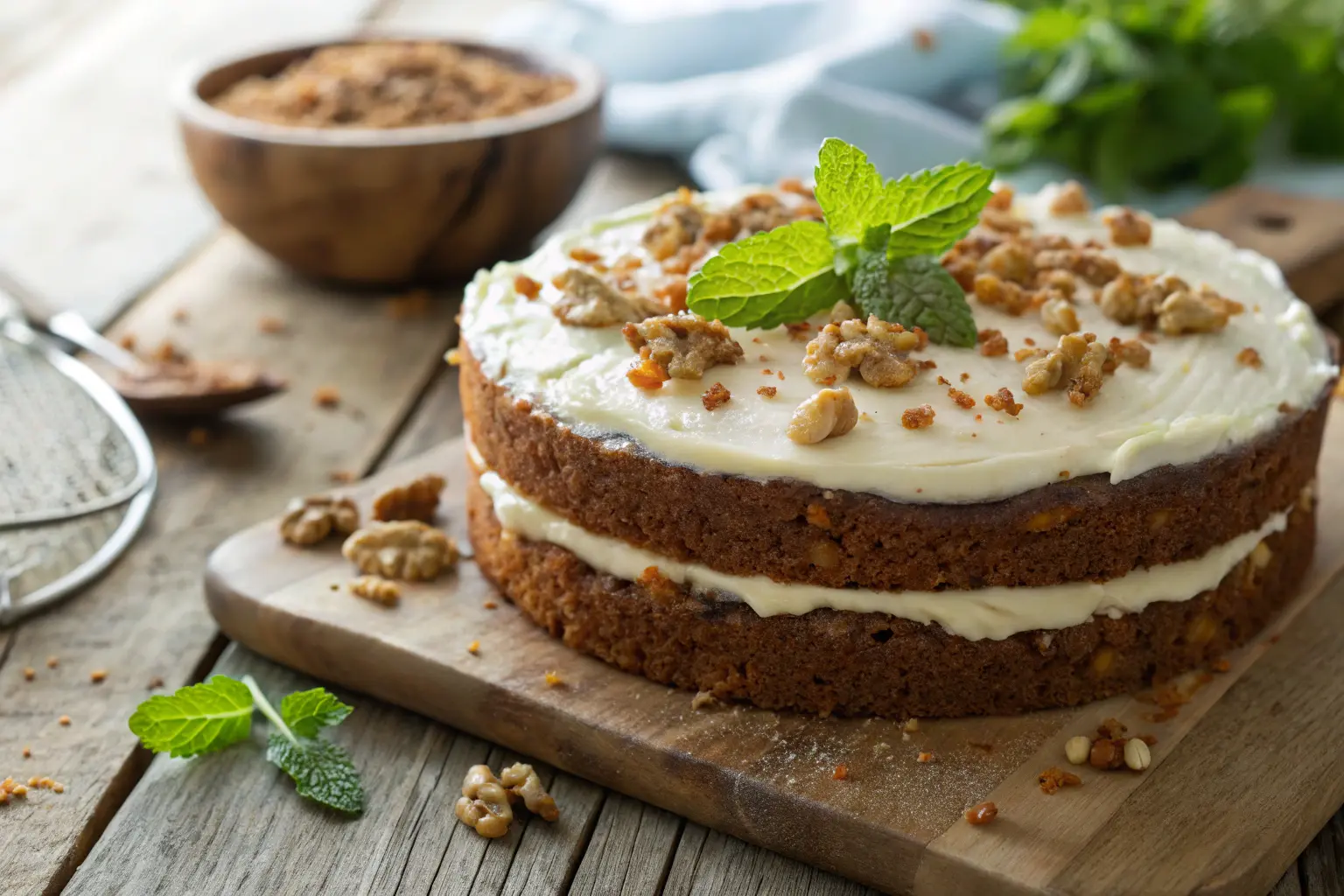Love desserts that are a little unexpected yet totally irresistible? Carrot cake is one of those rare treats that blends rich spices, natural sweetness, and creamy frosting into a single slice of joy. It’s moist, it’s flavorful, and it’s been a bakery favorite for decades.
In this guide, we’re diving headfirst into everything you need to know about this spiced carrot dessert — from its backstory and essential ingredients to baking tips, creative twists, and storage hacks. Whether you’re a seasoned baker or just starting out, you’ll walk away knowing how to whip up the best carrot cake right in your own kitchen.
We’ll also cover frequently asked questions people search online, answer common carrot cake dilemmas, and offer serving ideas that’ll wow your guests. Ready to get started?
Discover with us this easy and delicious recipe: Cake Ajinomoto Gyoza
What Is Carrot Cake?
### A Brief History of Carrot Cake
Carrot cake hasn’t always been the rich, frosted delight we know today. Back in medieval times, sweeteners like sugar were hard to come by. So, clever cooks started using naturally sweet ingredients—like carrots—to sweeten their desserts. Fast forward a few centuries, and by the 20th century, carrot cake became a beloved staple, especially in the United States during the health food craze of the 1970s.
#### Origins and Cultural Significance
Historically, grated carrots were added to puddings and dense cakes in Europe, particularly in England and France. Carrot pudding, the ancestor of modern carrot cake, was often served to royalty. As the recipe evolved, it transformed into a lighter, fluffier cake—especially after World War II when rationing encouraged bakers to get creative.
Today, homemade carrot cake symbolizes comfort food across generations and is a staple at celebrations like Easter, birthdays, and weddings.
### Why Carrot Cake is So Loved
Ask anyone who adores carrot cake, and they’ll probably say it’s the perfect combo of flavors and textures. It’s subtly spiced, incredibly moist, and often packed with delightful extras like nuts and raisins.
#### The Perfect Blend of Sweet and Spiced
What makes carrot cake truly stand out is the way it balances ingredients. The natural sweetness of freshly grated carrots mingles beautifully with warming spices like cinnamon, nutmeg, and allspice. Then there’s the rich, slightly tangy cream cheese frosting that complements every bite.
Discover with us this easy and delicious recipe: recipesfreesh
#### Unique Texture from Carrots and Nuts
The texture is where carrot cake steals the show. Unlike other cakes, it’s dense yet tender—never dry. The grated carrots create a moist crumb, while mix-ins like chopped walnuts or pecans add a satisfying crunch. Add-ins like pineapple, coconut, or raisins elevate it even further, giving you that homemade, rustic feel.
Table: Key Ingredients That Make Carrot Cake Unique
| Ingredient | Purpose in Carrot Cake | Flavor Contribution |
|---|---|---|
| Grated Carrots | Adds moisture, natural sweetness, and texture | Mild sweetness, earthy |
| Cinnamon & Spices | Enhances flavor complexity | Warm, aromatic, slightly spicy |
| Flour | Forms the cake’s structure | Neutral base for other flavors |
| Eggs | Binds ingredients and gives structure | Rich, helps with texture |
| Sugar | Sweetens the cake and helps it brown | Sweetness |
| Oil | Keeps the cake moist and soft | Neutral, allows spices to shine |
| Nuts (e.g. walnuts) | Adds crunch and depth | Nutty, rich |
| Pineapple/Coconut | Optional mix-ins for moisture and tropical notes | Tangy-sweet, chewy texture |
| Cream Cheese Frosting | Complements the spice and sweetness of the cake | Tangy, creamy, smooth |
Key Ingredients in a Classic Carrot Cake
Must-Have Ingredients for Authentic Carrot Cake
To bake a truly authentic carrot cake, getting the core ingredients right is non-negotiable. These are the building blocks that give the cake its signature texture, flavor, and aroma.
Freshly Grated Carrots
Let’s start with the star—carrots. Always go for freshly grated ones instead of pre-shredded. Why? Fresh carrots retain more moisture and natural sweetness, which makes your cake rich and tender. They also blend more easily into the batter, giving the cake that iconic soft-but-chunky crumb.
Flour, Sugar, and Leavening Agents
All-purpose flour is typically used for a traditional carrot cake. It’s strong enough to hold structure, but not too dense. Granulated sugar or brown sugar helps create a soft crumb and adds sweetness. Plus, brown sugar adds a hint of molasses flavor that really deepens the spice profile.
Baking powder and baking soda are your lifting agents here. They’re essential to avoid a dense, heavy cake and keep things nice and fluffy.
Optional But Delicious Additions
Want to take your carrot cake recipe from good to unforgettable? Try mixing in some of these optional ingredients.
Pineapple, Coconut, and Raisins
Adding crushed pineapple gives the cake extra moisture and a light tropical twist. Meanwhile, shredded coconut adds chewiness, and raisins bring bursts of sweetness. These ingredients turn a standard recipe into a moist, old-fashioned carrot cake that tastes like it’s straight from grandma’s kitchen.
Walnuts vs Pecans: Which is Better?
Both nuts work great, so it really comes down to preference. Walnuts give a slightly bitter, earthy crunch that balances the cake’s sweetness, while pecans are sweeter and softer. Toast them lightly before adding to the batter—it brings out the flavor and adds a subtle roasted aroma.
Ingredients to Avoid for Better Results
Even experienced bakers sometimes overdo it with mix-ins. A word to the wise: less is more.
Overly Moist Add-Ins
Too much pineapple or applesauce can make the cake soggy. Always drain pineapple well, and don’t overdo wet ingredients. You want a moist carrot cake, not a mushy one.
Artificial Flavors and Fillers
Skip synthetic vanilla or imitation spices. The charm of carrot cake lies in its natural, warm flavors. Using high-quality cinnamon, nutmeg, and fresh ingredients makes all the difference.
How to Make the Best Carrot Cake Step-by-Step

Prepping fresh ingredients for the perfect carrot cake.
Preparing the Ingredients Properly
Before you even preheat the oven, take time to prep. Believe it or not, how you prepare ingredients can make or break your cake.
Grating vs Shredding Carrots
Here’s a little-known secret: finely grated carrots are better than thick shreds. Finely grated carrots melt into the batter, releasing moisture and distributing evenly throughout the cake. Shredded ones, on the other hand, can clump and affect the cake’s rise.
Use a box grater or food processor for best results. And whatever you do, don’t peel the carrots too thin—they should have just enough flesh to grate cleanly.
Measuring Ingredients Accurately
Precision matters. Scoop and level your flour, don’t pack it. Use a digital scale if possible, especially for ingredients like oil and sugar. Even a few grams off can make the cake too dry or too wet.
Mixing and Baking the Batter
Now comes the fun part—bringing everything together.
Order of Mixing for the Perfect Texture
Always mix wet and dry ingredients separately first. Combine your eggs, oil, and sugar until smooth, then fold in the dry mix gradually. Finally, stir in the carrots and any extras like nuts or raisins.
Avoid overmixing. Stir just until combined, or you’ll end up with a dense, rubbery cake.
Best Baking Times and Temperatures
Bake your carrot cake at 325°F to 350°F. It may take longer than other cakes (usually 45–60 minutes) because of its moisture content. Use a toothpick to test—it should come out clean or with a few moist crumbs.
Use the middle rack of your oven and rotate the pan halfway through for even baking.
Tips for Moist and Fluffy Carrot Cake
Here’s where we unlock the magic.
Avoiding Overmixing
This one’s worth repeating. Overmixing activates the gluten in flour, leading to a dense texture. Stir gently and stop as soon as the ingredients are incorporated.
How to Know When It’s Done
Besides the toothpick test, look for a golden brown top and slightly pulling edges. The cake should spring back gently when touched.
Let it cool in the pan for about 10 minutes, then transfer to a wire rack. This helps avoid sogginess from steam and keeps that moist-but-airy texture we all crave.
The Best Frosting Options for Carrot Cake
Traditional Cream Cheese Frosting
There’s no denying it—cream cheese frosting is the classic pairing for carrot cake. Its tangy richness cuts through the cake’s sweetness, offering a balanced and irresistible finish. If you’re aiming for that bakery-style look and taste, this is the frosting to use.
Perfect Ratio of Sweetness and Tang
For a smooth, spreadable frosting, the golden ratio is simple: two parts cream cheese to one part unsalted butter, and just enough powdered sugar to sweeten it without overpowering the tang. A dash of vanilla adds warmth, while a pinch of salt brings all the flavors together.
This balance makes it perfect for piping or just spreading with a spatula. And because it holds well, it’s ideal for layer cakes or cupcakes.
How to Make It Smooth and Spreadable
The secret? Room-temperature ingredients. Cold cream cheese and butter can cause lumps, and overmixing can make the frosting runny. Beat until just smooth, and chill slightly before frosting if needed.
Alternative Frostings That Work
Not a fan of dairy? Or just looking to try something different? There are some delicious alternatives to the traditional cream cheese topping.
Vegan Cream Cheese Frosting
Made from plant-based cream cheese or cashews, this frosting mimics the tangy profile of the original. Add a touch of maple syrup or agave for sweetness, and use coconut oil or vegan butter for structure.
It’s just as luscious and pipes beautifully over vegan carrot cake cupcakes or loaf slices.
Whipped Coconut Cream
If you’re craving something lighter, whipped coconut cream is a dream. It’s airy, naturally sweet, and pairs perfectly with the spices in carrot cake. Chill full-fat coconut milk overnight, scoop out the solid part, and whip it with a touch of vanilla.
This option is especially good for dairy-free carrot cake lovers who want a guilt-free treat.
Frosting Mistakes to Avoid
Even the best frosting can flop if you’re not careful. Here are two common pitfalls to watch out for.
Over-sweetening the Frosting
Adding too much sugar dulls the cream cheese’s tangy flavor and can turn a perfectly balanced cake into an overly sweet bite. Always taste as you go, and remember: less is more.
Applying to a Warm Cake
This is a rookie mistake. Never frost a warm carrot cake—it’ll melt your beautiful topping into a sad puddle. Let the cake cool completely before adding frosting, or chill the layers if needed.
Creative Carrot Cake Variations You’ll Love

Carrot Cake Cupcakes and Muffins
Changing the format doesn’t mean losing the flavor. Cupcakes and muffins are a fun, easy way to serve carrot cake for events or pack them as grab-and-go snacks.
Perfect for Parties and Portion Control
Cupcakes are ideal for birthdays, baby showers, and office parties. Plus, they bake faster than full cakes, and you don’t need to worry about slicing or serving. Just top with a swirl of cream cheese frosting and maybe a sprinkle of chopped nuts or shredded coconut.
Tips for Baking in Small Sizes
Reduce the baking time to 18–22 minutes, and always use liners. Don’t overfill the cups—fill them about 2/3 full to avoid spillage. And here’s a tip: use an ice cream scoop for evenly-sized portions every time.
Gluten-Free and Vegan Carrot Cake Options
Whether for allergies or lifestyle choices, there are plenty of ways to make carrot cake more inclusive without losing flavor or texture.
Best Flour Substitutes
Almond flour and oat flour are both great choices. A gluten-free all-purpose mix can also work well. Add a touch of xanthan gum to help bind everything, especially if you’re not using eggs.
Egg and Dairy Alternatives
Mashed bananas, flax eggs, or applesauce can replace eggs, depending on the texture you want. Use plant-based milk and vegan butter or coconut oil to keep things moist. These swaps work beautifully for those making healthy carrot cake recipes at home.
Gourmet Versions for Special Occasions
Want to level up your carrot cake? These unique variations will impress at any gathering.
Carrot Cake Cheesecake
This hybrid dessert is pure genius. A spiced carrot cake layer beneath a creamy cheesecake layer creates a rich, indulgent bite. Add a graham cracker crust, and you’ve got a showstopper.
Layered Carrot Cake with Fancy Decorations
Stacked layers of carrot cake with cream cheese frosting between them and elegant decorations—like edible flowers, toasted coconut flakes, or even gold dust—can make your dessert table look stunning.
These gourmet carrot cake versions prove the dessert is as versatile as it is delicious.
Common Carrot Cake Baking Mistakes & How to Avoid Them
Baking the perfect carrot cake takes more than just a great recipe. Even seasoned bakers can slip up with simple mistakes that lead to dry texture, dense crumbs, or uneven results. Let’s walk through the most common issues and how to fix them.
Why Your Cake Might Be Too Dense or Gummy
Carrot cake should be moist but not heavy. If your slice feels more like a brick than a soft dessert, a few things might have gone wrong.
Overmixing or Not Enough Leavening
One big mistake? Overmixing the batter. This activates the gluten in flour, giving the cake a rubbery texture. Instead, mix just until the ingredients come together. Another culprit could be the leavening. If there’s not enough baking powder or baking soda—or if they’ve expired—your cake won’t rise well.
So, always use fresh leavening agents and measure carefully. A teaspoon too little can turn fluffy into flat.
Dry or Crumbly Carrot Cake
Nobody wants a dry cake, especially not when making one that’s known for being moist and rich.
Not Enough Oil or Grated Carrot
Oil is key to the moisture in carrot cake. Using too little or replacing it entirely with butter may lead to dryness. The same goes for carrots—don’t skimp on them. They not only add flavor but also lock in moisture.
Make sure you use freshly grated carrots, not pre-packaged shreds, as those tend to be dry and less flavorful.
Uneven Baking or Sunken Centers
If your carrot cake bakes unevenly or sinks in the center, the oven might be to blame.
Oven Temp Errors and Uneven Pans
Always preheat your oven, and don’t trust the dial. Use an oven thermometer for accuracy. Also, choose a good-quality baking pan that heats evenly. Avoid opening the oven door too often—that sudden drop in temperature can cause the center to collapse.
Position your cake in the center of the oven, and if you’re using multiple pans, make sure there’s space between them for air to circulate.
How to Store and Freeze Carrot Cake
Whether you’re baking ahead or saving leftovers, proper storage keeps your carrot cake fresh and delicious for days—or even weeks.
Best Storage Methods for Freshness
To preserve that moist crumb and flavorful frosting, storage is key.
Airtight Containers vs Refrigeration
If your cake is unfrosted, store it at room temperature in an airtight container for up to two days. For frosted carrot cake (especially with cream cheese frosting), refrigeration is best. Wrap it well or use a cake keeper to keep the texture soft and the flavors intact.
Refrigerated carrot cake stays fresh for about 4–5 days—just let it come to room temp before serving for the best taste and texture.
How Long Carrot Cake Lasts
Here’s a quick guide:
| Storage Method | Shelf Life |
|---|---|
| Room Temp (unfrosted) | 2 days |
| Refrigerated (frosted) | 4–5 days |
| Frozen (whole/sliced) | Up to 3 months |
Freezing Tips for Carrot Cake and Frosting
Need to freeze it for later? No problem. Carrot cake freezes beautifully—just follow a few simple rules.
Wrap Properly to Avoid Freezer Burn
Wrap the cake tightly in plastic wrap, then in foil, or place it in a zip-top freezer bag. You can freeze whole cakes, layers, or even individual slices. For frosted cakes, chill the cake first to harden the frosting, then wrap it carefully.
Thawing Tips to Retain Texture
To thaw, place the cake in the fridge overnight. Then let it sit at room temperature for about 30 minutes before serving. This helps bring back the soft, moist texture and keeps the frosting smooth.
Freezing a homemade carrot cake is a smart way to always have dessert ready, especially for last-minute guests or sweet cravings.
Serving Suggestions and Pairings for Carrot Cake

Pairing your carrot cake with the right beverage or garnish can take this classic dessert to a whole new level. Whether you’re hosting a brunch, celebrating a holiday, or just enjoying a slice on a quiet afternoon, the right accompaniments can elevate the entire experience.
Drinks That Complement Carrot Cake
Choosing the right drink is more than just pouring whatever’s handy. The warm spices in carrot cake open the door to some truly tasty drink pairings.
Coffee, Chai, and Dessert Wines
Rich, spiced drinks like chai tea or cinnamon-infused lattes bring out the earthy sweetness of the carrots and the nuttiness of the cake. A medium roast coffee adds a touch of bitterness that balances the cream cheese frosting beautifully.
Prefer something chilled or boozy? Try a light dessert wine such as a Riesling or Moscato. These slightly sweet sips can match the cake’s flavor without overpowering it.
Garnishes and Presentation Ideas
Let’s face it—a beautifully presented carrot cake makes an even bigger impact. Whether you’re frosting a layer cake or plating a simple square, these garnish ideas make your dessert stand out.
Toasted Nuts, Coconut Flakes, Edible Flowers
Lightly toasted walnuts or pecans not only add crunch but also a deep, roasted flavor. Sprinkle them over your frosting, or press them into the sides for a polished look.
Want something a little more playful? Add shredded coconut, candied orange peel, or even edible flowers like pansies or violets for a pretty pop of color.
Occasions Perfect for Carrot Cake
While carrot cake feels like a cozy treat, it’s surprisingly versatile when it comes to events.
Easter, Birthdays, and Weddings
It’s a go-to favorite at Easter tables, thanks to its spring-friendly flavors and festive feel. But it’s also becoming more popular at weddings—especially when dressed up as a naked cake with elegant toppings.
For birthdays, cupcakes or single-layer carrot cakes are simple, crowd-pleasing options. They’re easy to transport, decorate, and serve—no fancy skills required.
FAQs About Carrot Cake
People always have questions about making, storing, and modifying carrot cake. Here, we answer the most frequently asked ones based on what users search for in Google’s “People Also Ask” and AnswerThePublic.
Why is carrot cake so moist?
Carrot cake owes its famous moist texture to a combination of ingredients. Grated carrots release moisture as the cake bakes, while oil (instead of butter) traps that moisture inside. Additionally, ingredients like pineapple and brown sugar help lock in softness and keep the cake tender—even days after baking.
Can I make carrot cake without eggs?
Yes! There are plenty of egg substitutes that work well in carrot cake. You can use flax eggs (1 tablespoon ground flax + 3 tablespoons water), mashed bananas, or even unsweetened applesauce. These swaps maintain the moist texture while making the cake vegan-friendly.
What frosting goes best with carrot cake?
The classic is cream cheese frosting, hands down. Its tangy taste pairs perfectly with the sweet and spiced flavors of carrot cake. But if you need a dairy-free option, try whipped coconut cream or vegan cream cheese frosting made from cashews or plant-based butter.
Can carrot cake be made ahead of time?
Absolutely. In fact, carrot cake often tastes even better the next day! You can bake and frost it up to 2 days in advance. Just store it in the fridge and bring it to room temperature before serving. If you want to prep even earlier, freeze the unfrosted layers and frost them fresh.
How do you keep carrot cake from being dry?
Start with freshly grated carrots and avoid overbaking. Use oil for moisture and consider adding crushed pineapple for extra hydration. Most importantly, don’t overmix the batter—that alone can turn your cake dry and tough.
Is carrot cake healthier than other cakes?
It depends. While carrot cake has veggies in it, it still contains sugar and oil. However, when made with wholesome add-ins like whole wheat flour, coconut sugar, or dairy-free ingredients, it can definitely be a healthier dessert choice than traditional chocolate or vanilla cakes.
Conclusion:
So, what’s the final verdict on carrot cake? It’s timeless, flexible, and downright delicious. From its rich history to its irresistible texture, this spiced dessert has earned its place as a classic favorite—one that works for birthdays, brunches, weddings, and just about every sweet moment in between.
Whether you love it the traditional way with cream cheese frosting or prefer a modern twist like vegan carrot cake with whipped coconut cream, there’s a version of this cake for everyone. And don’t forget—you can bake it ahead, freeze it, dress it up, or keep it simple. That’s the beauty of this moist and flavorful dessert.
If you haven’t already, now’s the perfect time to experiment with your own homemade carrot cake recipe. Try new mix-ins, play with frosting styles, or just enjoy the classic combo that’s made this cake a crowd-pleaser for decades.

